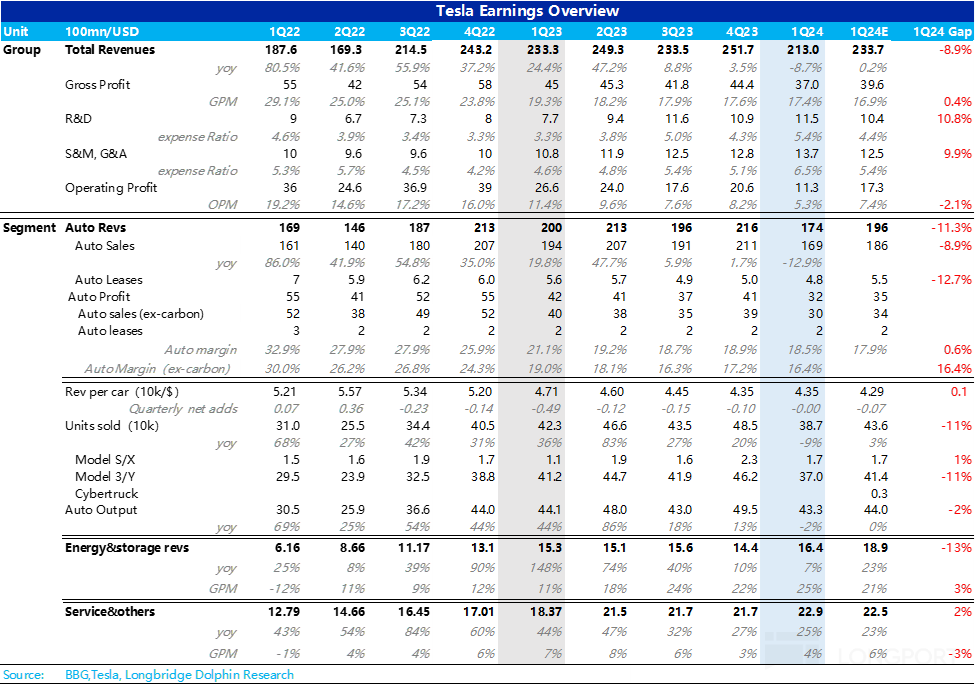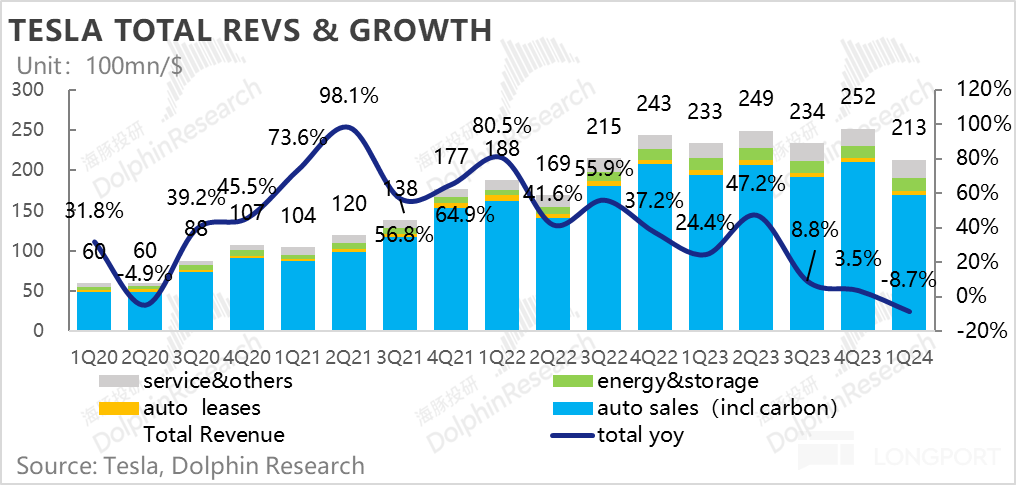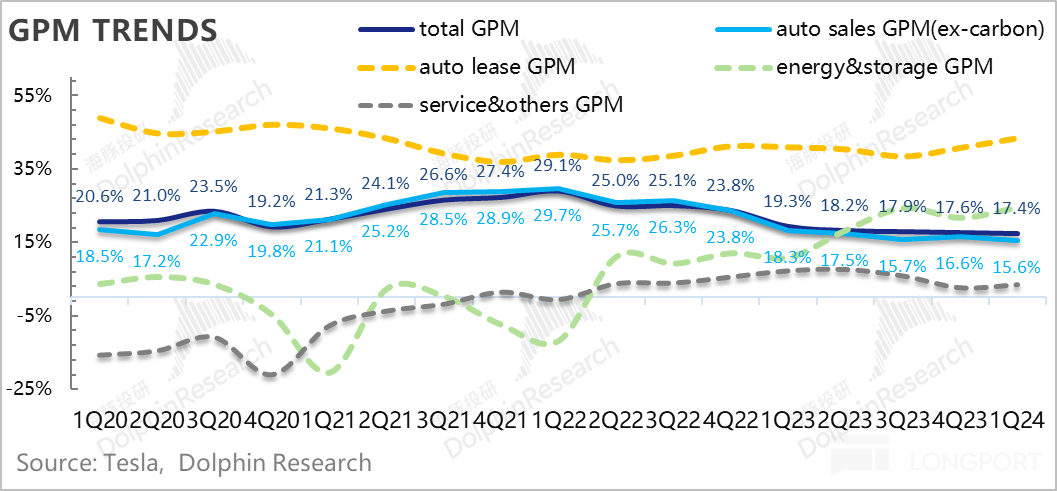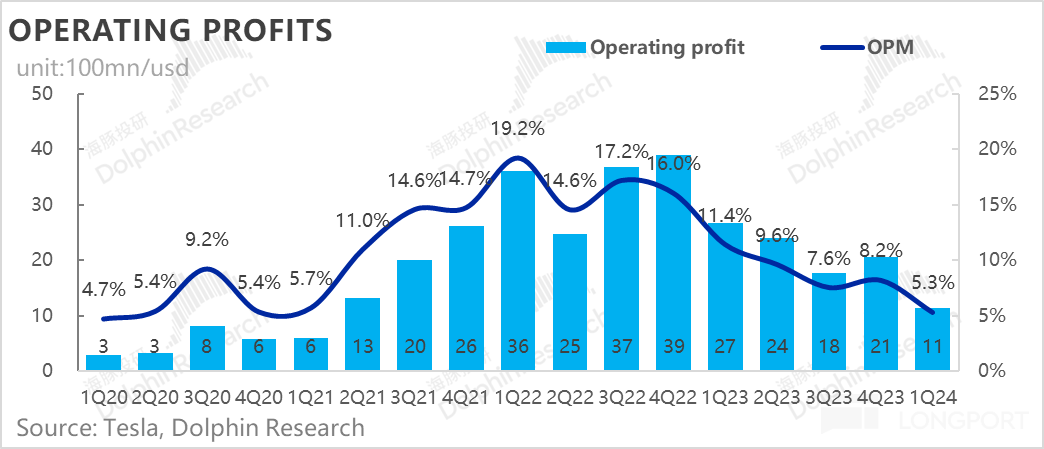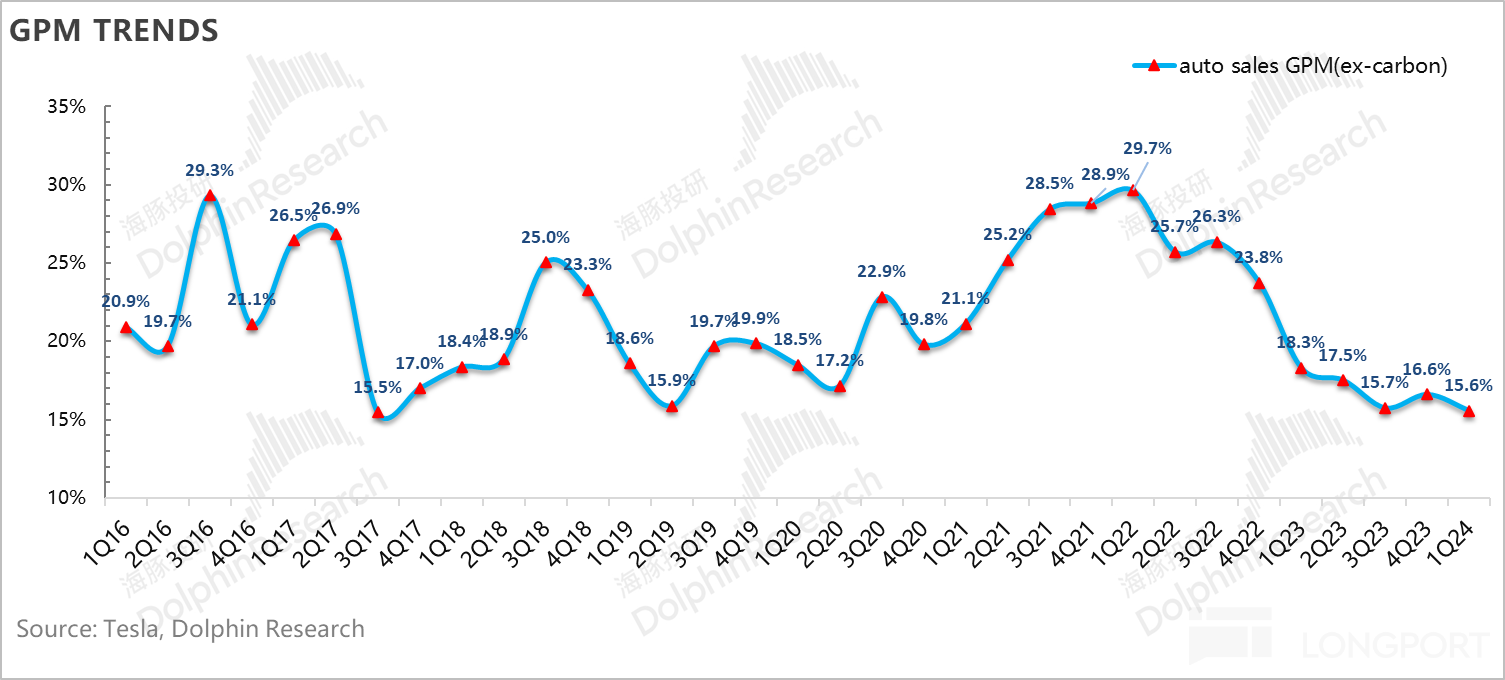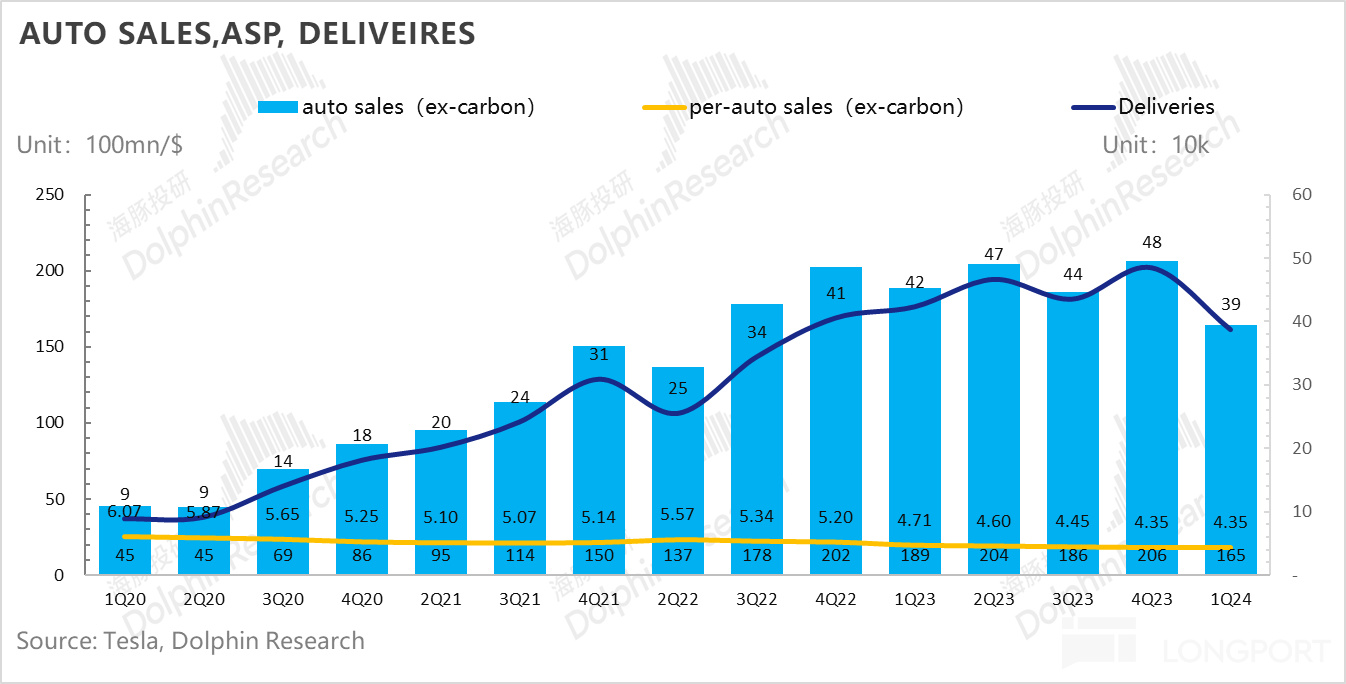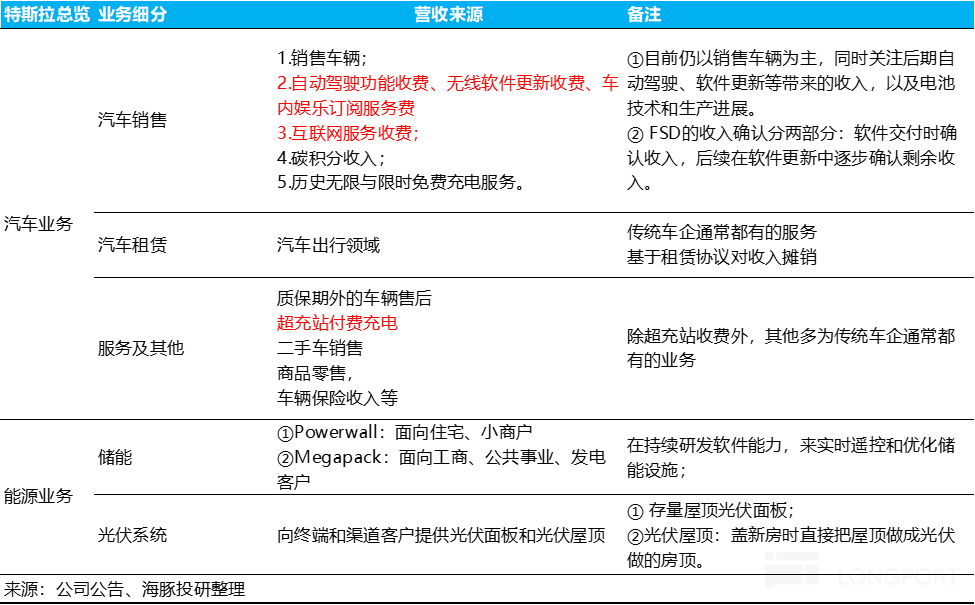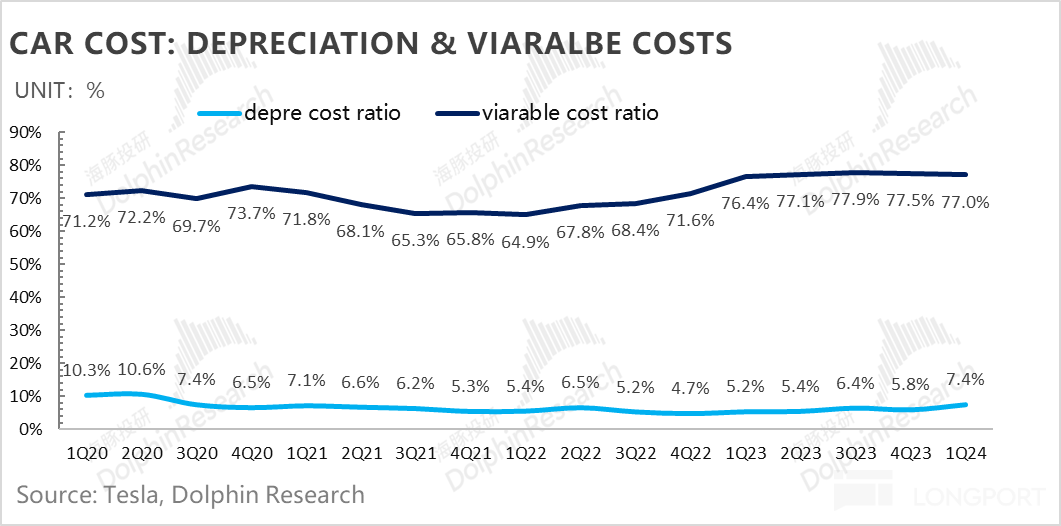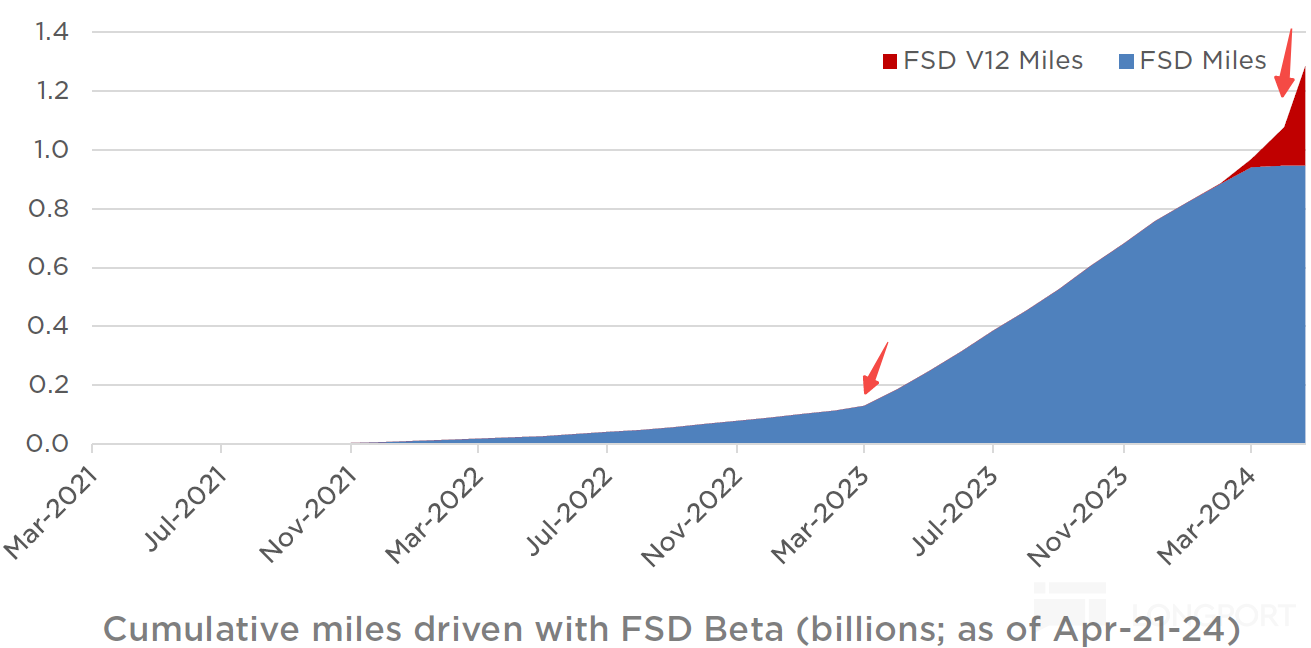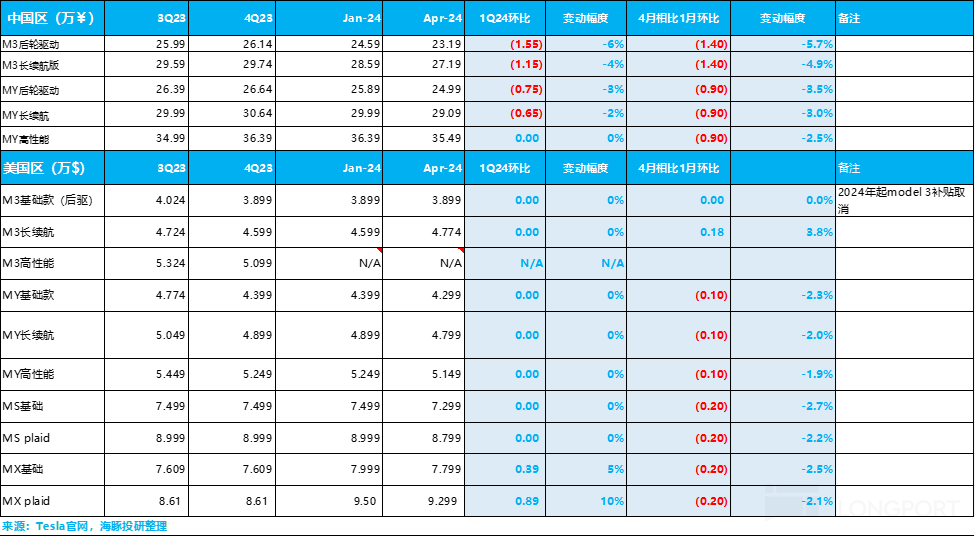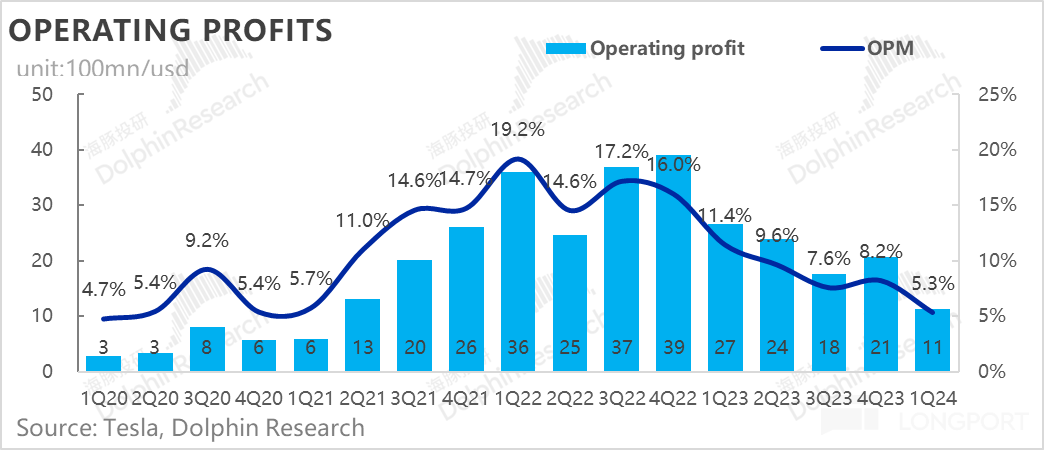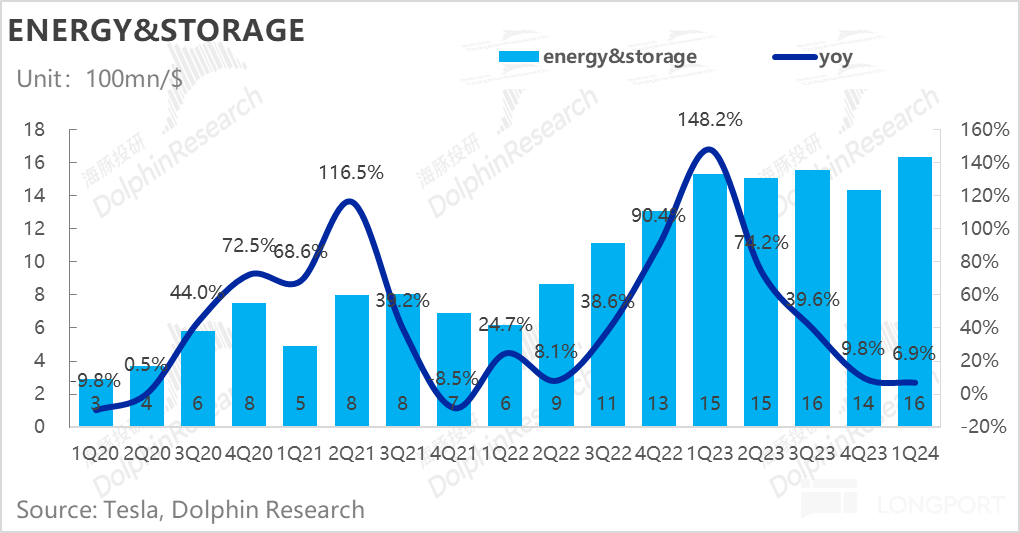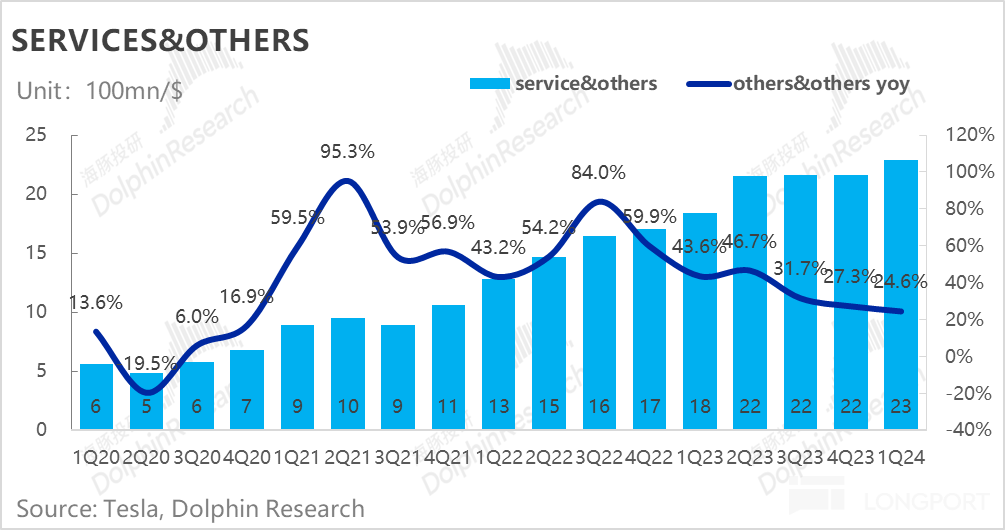
 Likes Received
Likes Received Posts
PostsFSD Contributes Master Strokes, Who Still Calls Tesla "Paper-Thin"?

Tesla (TSLA.O) released its first-quarter report for 2024 after the U.S. stock market closed on the early morning of April 24th Beijing time. As the optimistic narrative fades, waves of pessimism hit one after another, continuously pushing Tesla's stock price to new lows. However, in reality, Tesla is far from a tragedy:
1. Tesla's per vehicle revenue held up surprisingly well in the first quarter: Despite a $35 drop in per vehicle sales (excluding regulatory credits and car rentals) compared to the previous quarter, with price cuts in China and Europe and no improvement in the vehicle mix, Tesla managed to maintain its per vehicle price.
2. "Bright" per vehicle gross margin: The so-called brightness mainly refers to the fact that there was no collapse as expected by the market. The comprehensive gross margin for vehicles excluding credits only decreased by less than one percentage point, reaching 16.4%, far exceeding the market's expectation of 13-14%!
3. Per vehicle costs passed through carelessly: The fixed costs per vehicle were indeed poor due to weak sales volume, Cybertruck, and planned and unplanned production stoppages at various locations. Fortunately, there was a certain decrease in variable costs per vehicle, offsetting the increase in depreciation costs.
4. The real mystery: Therefore, the core reason for the better-than-expected per vehicle economics lies in per vehicle revenue. But why did per vehicle revenue hold steady? According to the company's explanation, this significant outperformance in per vehicle economics compared to the market's pessimistic expectations should mainly be attributed to FSD (for detailed explanation, refer to the main text).
5. Pay attention! Updates on Model 2 guidance: The key information is that the launch may be earlier, the price may not necessarily be so low, and the sales volume may not necessarily be so high; before the existing 3 million annual production capacity is fully utilized, the introduction of new production lines may be put on hold. Overall, this is a significant positive for financial expectations. The previous market expectation that Model 2 was doomed was overly pessimistic (for detailed explanation, refer to the main text).
6. Increased investment: Capital investment reached nearly $2.8 billion, hitting a new high, with no reduction in investment in autonomous driving and R&D investment in a single quarter also approaching $1.2 billion; amid sluggish sales demand, sales and administrative expenses also hit record highs, with marketing investment not yielding returns, hence sales being an area where layoffs are normal.
7. Operating profit of $1.1 billion, profit margin excluding the epidemic hits a five-year low: High expenses, coupled with negative revenue growth, further lowered operating leverage, while the gross margin remained strong.

Dolphin's overall view:
In the second half of last year, Dolphin expressed its views through three articles "FSD Smart Driving: Can't Support Tesla's Next Valuation Miracle", ["The Lion King Meets the Wolf Pack, Can Tesla 'Guard the Home'?"]Tesla: Facing Challenges in 2024 When systematically reviewing Tesla in articles such as "Tesla: How Far is Musk's Trillion-Dollar Empire Dream?" and "Tesla: Musk's Trillion-Dollar Empire Dream?", it has been made clear that Tesla will face challenges in 2024. Recent stock prices have already vividly illustrated these issues:
- Sluggish sales and significant layoffs indicate not only a slowdown in sales after the inflection point of new energy penetration rate, but also a further extension as the market believes that the attitudes of governments in Europe and America towards new energy are weakening.
- Product cycle: From the small product cycle in 2024, it has further evolved into no product cycle in 2025 and 2026, as the story of Model 2 has become increasingly mysterious.
- Diminishing AI halo: This is mainly due to Musk's previous active disengagement, expressing doubts about the development of AI within Tesla under the current control of Tesla.
- Betting on Robotaoxi and going all-in on autonomous driving—a highly uncertain business model due to policies and regulations in various regions, increasing uncertainty in both short-term and long-term investments.
In conclusion, for investors currently holding Tesla, the valuation of Tesla is still based on its automotive hardware business. Without this stable foundation, other aspects are fundamentally "in trouble."
However, looking at the first-quarter deliveries: the high-margin business of FSD V12 brings in revenue from FSD, stabilizing Tesla's gross margin. This is a clear positive for investors who recognize Tesla's autonomous driving business.
Regarding Model 2, the company has indeed lowered its priority, but strategically adjusting by utilizing existing car manufacturing platforms and existing production capacity to launch cheaper models early, implying reduced investment in the production capacity of cheaper cars. This is also positive news for investors focusing on the automotive business itself compared to the previously absolute pessimistic expectations.
It has been proven that for companies like Tesla with high valuations that rely on future realization and have highly fluctuating expectations, both excessively pessimistic and excessively optimistic views are equally dangerous.
Below is a detailed analysis of the financial report:
1. Tesla: Entering the Twilight Years?
1.1 First Negative Growth in Five Years
In the first quarter of 2024, Tesla's revenue was $21.3 billion, a nearly 9% year-on-year decline. This is the first time Tesla's revenue has shown negative growth since 2020 (when the Shanghai factory started selling cars and the Model 3 began selling well).
Despite falling short of expectations, the $21.3 billion total revenue performance appears significantly lower than the sell-side consensus expectation of $23.3 billion on Bloomberg, but this expectation was already outdated when sales figures were announcedCurrently, the latest updates from Dolphin indicate that the expected revenue for the major banks is around 21 billion US dollars, with no significant deviation in revenue expectations.
In fact, compared to the excessively pessimistic expectations in the automotive business, the actual performance in the first quarter was not as bad as expected: in terms of the automotive business, the first quarter sales of 387,000 units were in line with expectations. The key to the final revenue and gross profit of the automotive business lies in the unit price of the vehicles.
Despite Tesla lowering prices significantly in China and other regions, the main market in the United States actually saw slight price increases. As a result, in the first quarter, the average vehicle price did not decrease as expected. Therefore, although the automotive business appears to be at 16.9 billion, a 13% year-on-year decline, the revenue actually slightly exceeded expectations.
In addition, in two minor businesses that can only be considered marginal in terms of revenue, services grew by 25% year-on-year, operating normally. However, the energy business growth has slowed to single digits year-on-year, resulting in overall revenue being basically in line with market expectations despite the automotive business not performing as poorly as expected.

1.2 Gross Margin Held Up Well
In every performance report, the performance of the automotive gross margin has always been more significant than revenue, and the truly incremental information during financial reporting. Fortunately, in this aspect, Tesla not only did not perform as pessimistically as the market expected, but actually performed much better.
Due to the lack of significant sequential decline in average vehicle prices in the first quarter compared to market expectations, the energy business gross margin almost reached 25%, and the service business gross margin improved after expanding the coverage of non-Tesla users with supercharging stations in North America starting in February.
The overall gross margin of the group held up well, with a first-quarter gross margin of 17.4%. Despite the delivery of the low-margin product Cybertruck, it only decreased by 0.2 percentage points compared to the previous quarter.

However, on the expense side, due to Tesla's continuous investment in research and development in areas such as autonomous driving, DOJO supercomputing, robotics, and new vehicle platforms, and due to poor car sales leading to increased marketing efforts, research and development expenses and marketing/management expenses combined, in a situation of 9% negative revenue growth, increased by nearly 40% year-on-year, showing very poor operating leverage.
As a result, operating profit was only 1.1 billion US dollars, a nearly 60% year-on-year decline. The operating profit margin was only 5.3%, significantly lower than the market's expected 7.4%.

1.3 The Biggest Surprise: Unit Economics Held Up!As the most important observation indicator for each quarter, the gross profit margin of automobiles is crucial, especially in the current situation of declining sales and intensified competition. In order to clearly understand the true situation of the automobile gross profit margin, Dolphin has separately extracted the automobile sales gross profit margin excluding carbon credits, the automobile leasing gross profit margin, and the overall automobile business gross profit margin.
Due to the small scale of the automobile leasing business and its stable gross profit margin, the overall automobile gross profit margin is a comprehensive consideration of the two. The detailed breakdown is mainly for observing the automobile sales gross profit margin excluding carbon credits.
In the first quarter, the automobile sales gross profit margin (excluding carbon credits) was 15.6%, compared to 16.6% in the previous quarter, a decrease of slightly over one percentage point, but clearly not the significant decline of 13-14% as expected by the market.

Therefore, the key decryption here is how Tesla has maintained the unit price and gross profit margin of automobiles while frequently reducing prices and with the declining proportion of X/S/Cybertruck sales. How did Tesla achieve this kind of unit economics?
2. Unit Economics: Is the magic in FSD?
In the first quarter, Tesla's revenue per car sold (excluding carbon credits and automobile leasing sales) was $43,500, only a decrease of $35 compared to the previous quarter, which is almost negligible. This almost negligible decrease is one of the key market expectations.

The market originally expected that in the first quarter, Tesla in China would have significant price reductions (with reductions ranging from 2-6%, with an average reduction of around 10,000 RMB for Model 3 and Model Y). In addition, the price reductions in Europe in the first quarter were also generally between 4%-8%. Of course, after the price reductions, there were some minor price increases, but they did not affect the overall trend of price reductions.
The main offset was in the United States: prices slightly increased in the U.S. region (with a $1,000 increase for Model 3/Model Y). However, since China and Europe together account for over 50% of sales, it is unlikely that the significant price reductions in these two markets can be offset by the minor price increases in the U.S. region.
But strangely, the final unit price of Tesla in the first quarter remained stable at $43,500, with almost no change. Dolphin was able to find a real reason that can explain this issue, which is also the favorite story of AI faith funds - the increase in revenue from FSD!
Tesla did not specify how much FSD revenue was recognized in the first quarter, but emphasized that due to the release of FSD V12 (Beta), the revenue related to FSD increased significantly in the first quarter. Note that this type of software revenue, which is fee-based, is recorded in automobile sales revenue. Therefore, when this type of software revenue increases, it indirectly raises the per-car revenue of automobiles, as well as the gross profit margin.

After discussing the firm pricing of bicycles, let's talk about the cost of bicycles. Generally speaking, Tesla's cost reduction stems from four dimensions - 1) dilution of scale from sales volume release, full utilization of production capacity; 2) technological cost reduction; 3) natural cost reduction of battery raw materials; 4) government subsidies.
However, sales were sluggish in the first quarter of this year, all Model 3 federal tax credits in the United States were canceled, and the Cybertruck also dragged down the gross margin, with planned production stoppages in the US factory due to the transition from old to new models, and unexpected production stoppages in the German factory due to arson incidents. In addition, factors such as the Red Sea incident affecting the supply chain have also dragged down the gross margin. The only thing that could support the gross margin, apart from high-margin businesses like FSD, was the natural reduction in materials costs. However, it is in this aspect that Tesla's performance this quarter has been exceptionally outstanding.
The extent of this excellence even made Dolphin Jun doubt that the new Model 3/Y might have had a certain gross margin premium on the initial list price, rather than what the company claimed, that the price increase for the new product only covered the additional costs of product improvement.
2.1 Price reduction to boost sales, bicycle economics unsustainable
Dolphin Jun breaks down the cost of bicycles into bicycle depreciation and variable costs. The first quarter's bicycle economics is as follows:
1) Poor bicycle depreciation effect: With declining sales, the US factory's new models climbing, Cybertruck entering the market leading to depreciation of the production line, and factors such as the German factory's production stoppage due to arson, the quarterly per-bicycle depreciation cost was $3,220, which is significantly higher than when the per-bicycle depreciation was above $3,000 and quarterly sales were between 200,000 to 300,000 units. Each vehicle in the last quarter incurred an additional $678 in depreciation.
2) Bicycle variable costs: The bicycle variable cost in the first quarter was $33,500, a decrease of $253 compared to the previous quarter, mainly due to cost reductions in raw materials, lower freight prices, and tariff improvements.

3) Automobile gross margin further declines: Ultimately, due to stable bicycle prices, the actual per-bicycle gross margin only decreased by $460. The truly remarkable aspect of this quarter's bicycle economics is that the bicycle prices remained stable, which is a pleasant surprise from FSD.

2.2 Pressure from unit sales leads to a decline in vehicle sales revenue: In the first quarter, the total revenue of the overall automotive business (including credits) was $17.4 billion, a 13% year-on-year decrease, mainly due to poor sales volume.
Regulatory credits accounted for $442 million this quarter, showing a relatively stable performance. Currently, the impact of carbon credits on Tesla's current revenue and profit has diminished significantly2.3 If the sales volume and gross profit margin outlook for Tesla in 2024 are not optimistic, what else can Tesla focus on in 2024?
In the first quarter, Tesla's gross profit margin compared to the market expectations was indeed very good, mainly driven by the Full Self-Driving (FSD) revenue. The key focus should be on the sustainability and explosiveness of FSD revenue.
In the first quarter, Tesla has already launched FSD (Beta version), offering a 30-day free trial to some users in North America and Canada. Moreover, the company has recently reduced the price of FSD in North America from $12,000 to $8,000 and in Canada from $16,000 to $11,000 USD, showing a significant price cut. This indicates a strong determination to rapidly increase the penetration rate of FSD. (For a detailed analysis of Tesla's intelligent driving by Dolphin, please click here)
According to the latest information disclosed by the company, Tesla's cumulative autonomous driving mileage saw a nonlinear growth when the FSD Beta version was launched in March 2023, followed by a normal growth rate. In April 2024, after Tesla started offering a 30-day free trial, the mileage surged again.
The key focus for future Tesla investments is how the penetration rate will be affected after the price reduction of the new FSD+ version. The subscription rate of users is also crucial. In a year with lower car sales, this is the core aspect to consider for Tesla's valuation this year.

As the automotive business is currently in a downturn, and the next big profit booster Model 2 is expected to be discounted, while the short-term deployment of Robotaxi is uncertain due to regulatory and technological issues, the remaining investment prospects rely on the upward support brought by the logic of increased penetration rate after the price reduction of FSD V12.
Whether Model 2 will be canceled or delayed may require close attention to any possible information and guidance provided by the company during the conference call. Dolphin will publish the summary on the Longbridge APP, so please stay tuned.
2.4 The question everyone is focusing on: Will there be a Model 2? When will it arrive?In the first quarter, the uncertainty of Tesla's gross profit margin remains due to the removal of the "thunder" caused by the one-time revenue recognition from the FSD update, and the uncertainty of the ultimate penetration rate of FSD V12.
The key question is still about Tesla's growth in 2024 and beyond. Where is the bottom line and steady state of the gross profit margin? These are the questions that the market hopes to see answered in the first quarter of the new year. Especially, does the Model 2 still exist? When will it be available? Have there been any changes in the planned sales volume?
Fortunately, Tesla has provided a clear answer to this question this time, because it is too important. Here is the detailed explanation:
a. Tesla is currently in a transition period between two major growth cycles (AKA: a period of transition) - the first round is the global product cycle initiated by the Model 3, and it is believed that the second round will come from the advancement of autonomous driving and the launch of new products, including the models to be launched on our next-generation vehicle platform.
Dolphin's understanding: In this description of the major cycle, Tesla's description of the next major growth is autonomous driving, followed by new models under the affordable platform. Compared to previous communications, the sequence has changed, and the focus has shifted - Tesla's importance judgment on the Model 2 is decreasing.
b. We have updated our future vehicle product line, and production of the new models will start in the second half of 2025, which will accelerate the launch of new models.
Dolphin's understanding: This is a significant positive development because the market competition is constantly changing, and Tesla's 7-8 year cycle for product updates is too slow compared to Chinese new energy vehicle peers!
c. These new models, including more affordable versions, will be produced on our next vehicle platform, and will also utilize our current platform, and will be manufactured on the production lines of existing models. This update may lead to a reduction in the expected cost reduction rate, but it can allow us to cautiously increase sales growth with higher capital utilization efficiency during uncertain times. This can also allow us to maximize the current nearly 3 million maximum annual production capacity, ensuring a growth of over 50% compared to 2023 before investing in new production lines.
Dolphin's understanding: This is the biggest strategic adjustment. Originally, the Model 2 was a product under the new platform, but now the old platform will also produce affordable cars. This likely indicates that either the Model 2 will not be as cheap in the end, or in addition to the Model 2, there may be products coming out with prices between the Model 2 and 3, and it is very likely that it will no longer be a rigid focus on cost reduction through technology, but rather selective de-contenting. This is a major shift in product strategy, and Dolphin dare not speculate, but rather wait for Tesla's detailed explanation.
In terms of production planning, the pace of investment in new factories in Mexico and even India has become highly uncertain. The investment pace of new factories is likely to slow down significantly, focusing on maximizing the production capacity of existing factories such as the Shanghai and German factoriesIn this case, inevitably, the sales expectations of Model 2 will be greatly reduced. However, based on the current market valuation (around $130 per share), there is basically no valuation for Model 2. The current cautious approach—cautiously slowing down capital expenditure in car production—is equivalent to still giving a certain sales expectation for Model 2, and this sales volume is expected to come earlier. By stabilizing capital expenditure, it also to some extent stabilizes future gross margin expectations, which is a clear positive signal.
Looking at it this way, indeed Tesla still faces many problems, such as:
1) Unable to maintain prices: A new round of price reductions started in the global market in April: China reduced by about 3-6%, although there was a small price increase in the United States, the Model Y subsidy may decrease from $7500 to $3750, with a large inventory backlog. Tesla in the United States reduced prices by 2-4%; market demand is weak, and the market no longer has hope for Tesla's sales in 2024, with the lowered expectations basically assuming zero growth in 2024 except for an increase of about 125,000 units for the Cybertruck.

2) Accumulated inventory: Tesla's inventory accumulated significantly in the first quarter. Observing it using the cumulative value of Tesla's production-sales difference (because Tesla is directly operated, the production-sales difference is the inventory held by Tesla + vehicles already shipped but not yet delivered to users), the inventory including vehicles in transit had accumulated to 153,000 units by the end of the first quarter, accounting for 35% of the quarterly production, with inventory turnover days of 28 days, almost doubling from the previous around 15 days.

However, the two positive signals released in this financial report will inevitably lead to a significant upward revision of market expectations:
a. The increase in FSD penetration rate may significantly boost the gross margin of the automotive business; subsequent focus will be on the progress of the actual payment penetration rate of users after the FSD free trial period.
b. Regarding the automotive business, cheap cars will arrive early, requiring revenue to be injected early; prices may not necessarily be too low, and existing production capacity will be fully utilized, so gross margin expectations do not need to be too low; sales outlook needs to be adjusted downwards.
In the end, under intense market competition, Tesla ultimately made a trade-off between market share and gross margin of cars. In the short term, Tesla will no longer play the game of producing and selling as much as possible, and the gross margin bottom line for 2025 should be able to stabilize.
Overall, the signals released in this financial report are much better compared to the market's grim expectations.
III. Expenditure side: All in on autonomous drivingTesla has become more cautious in investing in automotive production capacity, but it remains generous in its capital investment in autonomous driving. Capital expenditures in the first quarter have reached nearly $2.8 billion, with research and development investment of $1.15 billion, both hitting record highs, especially the capital expenditure.
Under the situation of product sales stagnation, both sales and administrative expenses have increased significantly, with more people leading to lower sales volume. The performance of marketing expenses is worse than that of research and development. This situation naturally brings to mind Tesla's global layoffs, with sales being the hardest-hit area in this round of layoffs.

In the end, due to weak revenue and high expenses, Tesla's operating profit was only $1.1 billion, with an operating profit margin of 5.3%, hitting a five-year low without considering the disruption of the pandemic.

4. Energy Slows Down, Services Continue to Innovate
4.1 Energy Slows Down: Tesla's energy storage and solar business include selling solar systems and energy storage systems to residential customers, small and large commercial customers, and utility-level customers.
In the first quarter of this year, revenue reached $1.6 billion, with growth slowing to single digits at 7%, significantly lower than market expectations. The solar roof business has fallen into negative growth, and Tesla has stopped disclosing installation volumes. Due to high interest rates and a narrowing gap between oil and electricity prices, demand for solar roofs is decreasing.
However, the energy storage business continues to grow, with an increase in installation volume by 4%. The energy storage business locks in prices with advance orders, and due to the current relationship with lithium prices, the gross profit margin of the energy business has reached a new high of nearly 25% as lithium prices continue to decline.
However, no matter how stable and high the gross profit margin is, the revenue volume is too small, and the growth rate is not high enough to make up for the huge gap in the automotive business.

4.2 In the first quarter, Tesla achieved service revenue of $2.3 billion, a year-on-year increase of 25%. Charging piles, insurance, and other innovative businesses are all included in this segment. However, at present, the largest contribution to revenue in this segment still comes from selling car parts and used cars.
Fortunately, starting in February of the first quarter, Tesla began to open up its charging pile business in North America to more third-party non-Tesla users. The innovative business not only began to contribute revenue but also gradually improved the gross profit margin of this segment, with the gross profit margin in the first quarter increasing to 3.5% month-on-month.

Dolphin's historical articles, please refer to:
Interpreting the financial report on January 25, 2024: "Tesla without the AI facade: the endless price, the unstoppable bleeding"
Financial report conference call on January 25, 2024: "Tesla's fourth-quarter summary: Sales volume in 24 years falls short of '50%', but expenses keep rising"
Hot review on December 1, 2023: "Tesla Cybertruck: High pricing, low economy"
Interpreting the financial report on October 19, 2023: "Killing the bubble moment! Tesla, facing harsh reality"
Financial report conference call on October 19, 2023: "[Slow progress in CT, slow factory construction in Mexico, Musk's bankruptcy 'phobia']](https://longportapp.cn/zh-CN/topics/10287403?app_id=longbridge&channel=t10287403&invite-code=276530&utm_source=longbridge_app_share)"
In-depth analysis on October 12, 2023: "FSD autonomous driving: Can't support Tesla's next valuation miracle"September 22, 2023 In-depth "The Lion King meets the Wolf Pack, can Tesla 'keep an eye on home'?"
September 19, 2023 In-depth "Tesla: How far is Musk's 'trillion-dollar empire dream'?"
September 1, 2023 Hot Comment "New Model 3 on sale, prices rise instead of fall?"
July 20, 2023 Financial Report Analysis "Trillion-dollar Tesla, only true fans dare to embrace"
July 20, 2023 Financial Report Conference Call "Tesla Minutes: Gross margin breached, Tesla may continue to lower prices"
April 20, 2023 Financial Report Analysis "Tesla: Big year on paper, small year in reality, 'long-term companionship' is too difficult"
April 20, 2023 Financial Report Conference Call "Tesla: Confident in selling cars at zero profit, harvesting with autonomous driving"
January 26, 2023 Financial Report Analysis "Tesla's story reshaped, the moment of testing faith has come!"
January 26, 2023 Conference Call "Tesla Minutes: 'No opponent even with a telescope for autonomous driving, the second Tesla may be in China'" Financial Report Analysis on October 20, 2022: "Critical Question: How to Maintain Profitability When Demand is Insufficient for Single Bicycles?"
Minutes of the Telephone Conference on October 20, 2022: "Summary: 'Internal Combustion Engine Cars Are Doomed, Production Will Not Decrease at Any Time'"
Financial Report Analysis on July 21, 2022: "Without the Lifeline of the Shanghai Factory, What Can Tesla Rely On?"
Telephone Conference on July 21, 2022: "Musk: 'Raising Prices Repeatedly, I'm Unstoppable'"
Opinion Update on June 6, 2022: "Did the US Stock Market Tremors Mistakenly Kill Apple, Tesla, and NVIDIA?"
April 21, 2022: ""New Energy Thundering, Tesla Continues to Soar""
April 21, 2022: "New Factory Production Capacity Ramping Up, Tesla to Deliver 1.5 Million Vehicles in 2022 (Meeting Minutes)"
Opinion Update on February 28, 2022: "With Scattered Hearts, Safety Comes First When Investing in Tesla"
Telephone Conference on January 27, 2022: "Tesla: Musk Reiterates the Importance and Value Potential of FSD (Telephone Conference Summary)"
Financial Report Review on January 27, 2022: "Tesla, the Unstoppable Force, Will Take a Midterm Break?"2021 December 6th Viewpoint Update "What's next for Tesla's stock price as Musk sells tickets to make up for taxes?"
2021 October 21st Conference Call "Tesla: A million annual sales within reach, will Musk let go?"
2021 October 21st Earnings Review "Tesla: Cathie Wood shouting $3000, is the sky the limit?"
2021 July 27th Conference Call "Tesla Q2 2021 Earnings Conference Call Summary"
2021 July 27th Earnings Review "Tesla: Not the most bullish, only more bullish!"
2021 April 27th Conference Call "Tesla 2021 Q1 Earnings Live Summary"
2021 April 27th Earnings Review "After a first quarter report with no surprises or shocks from Tesla, what else can be expected?"
2021 June 3rd In-depth "Tesla (Part 2): Was it a mistake or overvaluation, where does Tesla's story go from here?"
2021 May 21st In-depth "10 years, 300 times growth, how much longer can the 'magical' Tesla continue?"
Risk Disclosure and Disclaimer for this article: Dolphin Research Disclaimer and General Disclosure
The copyright of this article belongs to the original author/organization.
The views expressed herein are solely those of the author and do not reflect the stance of the platform. The content is intended for investment reference purposes only and shall not be considered as investment advice. Please contact us if you have any questions or suggestions regarding the content services provided by the platform.

